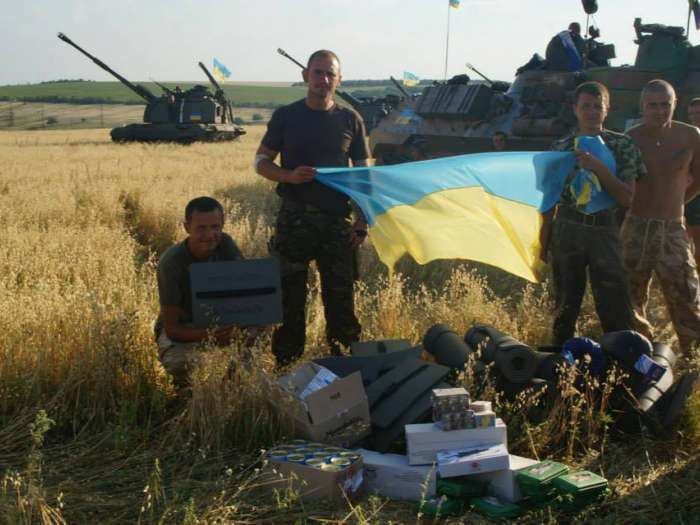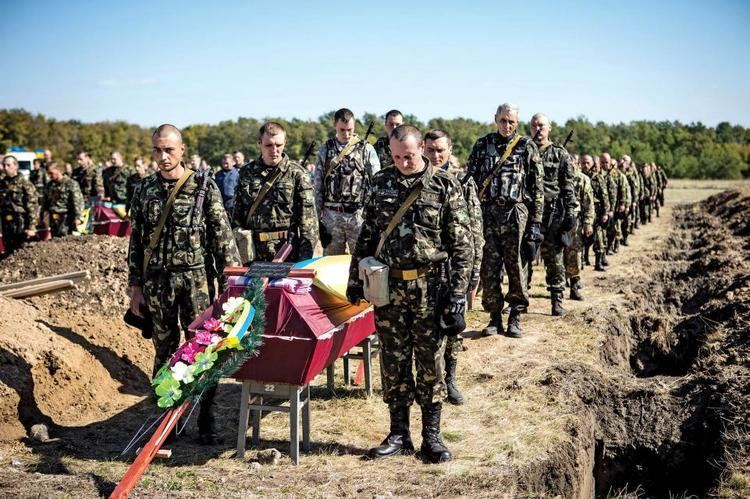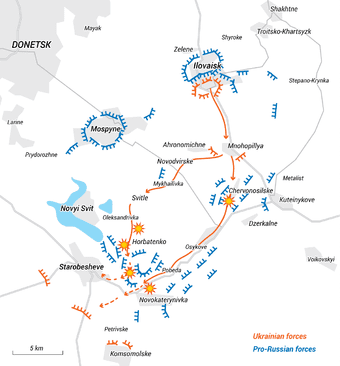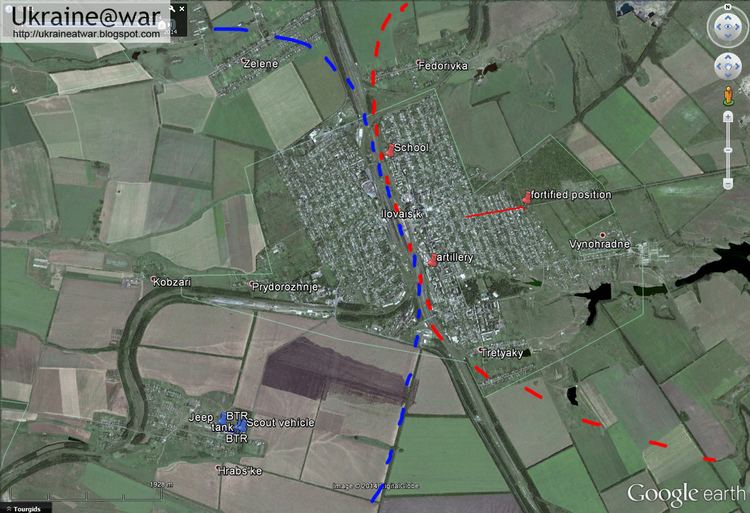Encircled forces1,200–1,400Deblock forces~400 4,000–4,100 | Dates 10 Aug 2014 – 2 Sep 2014 | |
 | ||
Similar War in Donbass, Battle of Debaltseve, Battle in Shakhtarsk Raion, Battle of Marinka, Mariupol standoff | ||
The Battle of Ilovaisk started on 7 August 2014, when the Armed Forces of Ukraine and pro-Ukrainian paramilitaries began a series of attempts to capture the city of Ilovaisk from pro-Russian insurgents affiliated with the Donetsk People's Republic (DPR). Whilst government forces were able to enter the city on 18 August, they became encircled during 24-26 August by overwhelming Russian military forces that crossed the border, joining the battle. After days of encirclement, government forces made an agreement with the insurgents, favoured by Russian president Vladimir Putin, to allow them to retreat from the city. This agreement was not honoured, and many soldiers died whilst trying to escape.
Contents
- Events
- Government forces enter Ilovaisk
- Encirclement of government forces Ilovaisk under siege
- Attempt to deblock encircled forces
- Government forces retreat and massacre
- Casualties
- Aftermath
- References

Chief of the General Staff and Commander-in-Chief of the Armed Forces of Ukraine Viktor Muzhenko stated on 26 August 2016, that the cause behind the battle's outcomes was the involvement of Russian troops, along with Ukrainian commanders' incompetence in the planning of the retreat.

Events

Ilovaisk is an important city between the insurgent strongholds of Donetsk and Luhansk. Government forces hoped to cut-off insurgent supply lines between these two cities, and hence intended to rout insurgents from the city. Government forces made their first attempts to breach the DPR-controlled city on 7 August 2014. Artillery fire was reported in the town on 10 August 2014. Over the next few days, government forces made multiple attempts to enter the city, but were bogged down by heavy fighting with the insurgents.
Government forces enter Ilovaisk

Government forces made an attempt to enter Ilovaisk during the day on 18 August, but failed. Led by the Donbas Battalion, government forces made another attempt to storm the city on the night of 18–19 August. This attempt was successful, and they raised the Ukrainian flag over the city administration building without any casualties. Ukrainian media viewed this victory as an example of the strength and effectiveness of the government "Anti-Terrorist Operation" (ATO) against the insurgents. As government forces entered the city, Donbas Battalion commander Semen Semenchenko was wounded after being struck by mortar fire and was evacuated for medical treatment. Following the flag-raising, the Internal Affairs ministry said that Ukrainian military, including the Donbas, Dnipro and Azov, were clearing the city of "terrorists", specifically mentioning that they killed "a great number" of insurgents from the Oplot Battalion of the Donbass People's Militia. They also said that reinforcements from the National Guard of Ukraine were forthcoming. After a day of fighting, roughly fifty percent of Ilovaisk was under government control. Governments forces also captured six insurgents, including one Serbian volunteer. Azov and Shakhtarsk battalions left the battle of Ilovaisk that day, heading to reinforce garrisons of Mariupol and Komsomolske cities accordingly.
On the following day, 20 August, government forces said they took complete control of Ilovaisk. This was denied by DPR officials, who said that they remained in control. Over the course of the day, government forces fought off numerous insurgent counter-attacks. Street battles took place across the city, and at least nine Ukrainian soldiers were killed in the fighting. Following this, the Donbas Battalion requested reinforcements. By 21 August, amidst heavy and constant fighting, the Internal Affairs ministry stated that twenty-five percent of those from volunteer paramilitary battalions killed since the ATO began were killed in Ilovaisk. No reinforcements for government forces arrived. According to commander Semenchenko, some members of the Donbas Battalion were killed when insurgents flying the Ukrainian flag attacked an ambulance. Semenchenko described this act as "medieval savagery". He also said that the Donbas Battalion had been "abandoned" by both the Ukrainian government and the other volunteer paramilitary battalions, both of which largely withdrew from the city.
Encirclement of government forces; Ilovaisk under siege
The remaining government forces in Ilovaisk became completely encircled by DPR insurgents and Russian reinforcements on 24–26 August, and the fighting continued to take its toll. Ukrainian soldiers started seeing Russian regular army troops on 24 August, and their presence increased over the next few days.
On 24 August, around 12:15 AM, a column of BMD-2s of the 331st Airborne Regiment was hit by a Ukrainian anti-tank squad of the 51st Mechanized Brigade near Kuteinykove village. Two BMD-2's were destroyed. The paratroopers left their vehicles and took cover in trees nearby. Several hours later, around 5 PM, they left their cover and were captured by the reconnaissance group of the 51st Mechanized Brigade near Dzerkalne village, the Ukrainian battalion tactical group's field headquarters. Ten paratroopers were captured.
On 26 August, a T-72B3 tank of the 6th Tank Brigade was captured by Ukrainian troops of the 51st mechanized brigade in a fight near Ahronomichne village. The captured tank took part in another fight that day near Mnohopillya village where the Russian column of mixed 8th Mountain brigade's and 31st Air Assault brigade's units was ambushed by Ukrainian anti-tank artillery squad of 51st Mechanized brigade. 2 soldiers of the 31st Air Assault Brigade and one wounded soldier of the 8th Mountain Brigade were captured by Ukrainian forces.
According to the DPR, a large number of Ukrainian soldiers and paramilitaries were trapped in the town. During the fighting, the Ukrainian commander of the Dnipro Battalion suffered a concussion, while the commander of the Kherson Battalion was killed. In response to commander Semenchenko's pleas, many Euromaidan activists in the Ukrainian capital Kiev protested what they saw as the government's "abandonment" of the volunteers fighting against the insurgents. Repeated artillery barrages launched by insurgent forces from nearby villages caused heavy casualties amongst the trapped government forces.
Attempt to deblock encircled forces
Ukrainian command tried to deblock encircled forces near Ilovaisk. The company tactical group was formed from 92nd Mechanized Brigade that had 276 soldiers, 4 tanks, 3 SPGs and 10+ IFVs. It was sent from Kharkiv oblast in direction of Ilovaisk on 24 August 2014, after it became clear Russian military forces approached Ilovaisk. The unit was supposed to meet an assault squad of Rukh Oporu Battalion and try to breach Russian encirclement. Rukh Oporu squad had 90 soldiers and was beefed with 2 IFVs. 92 Brigade's company arrived on 27 August to Komsomolske city and advanced towards Ilovaisk. The column stopped in the field for a night and shortly after it was hit by heavy artillery shelling. The next morning it was completely defeated by Russian paratroopers, losing most vehicles but having relatively low troops casualties with 8 people dead and several missing. The same fate had Rukh Oporu squad which was defeated on 28 August morning nearby, the units never met.
Government forces retreat and massacre
After days of being under siege in Ilovaisk, commanders of government forces in the city attempted to negotiate an agreement that would allow them to withdraw from the city. Russian president Vladimir Putin said in the early morning on 29 August that a "humanitarian corridor for besieged Ukrainian soldiers" should be established, allowing the trapped soldiers to leave Ilovaisk. Yuriy Bereza, a commander in the Dnipro Battalion, managed to quickly reach an agreement with Russian commanders in Ilovaisk to establish such a corridor. DPR prime minister Alexander Zakharchenko confirmed that an agreement had been made, and also said that Ukrainian forces were required to leave their armoured vehicles and ammunition behind as a condition of the agreement.
On 29 August at 06:00, government forces began to move out of Ilovaisk in a column of sixty vehicles. At 8:00, government forces regrouped at Mnohopillya, just south of Ilovaisk proper, forming 2 columns, Northern and Southern, and prepared to withdraw. Northern column led by Gen. Ruslan Khomchak was formed from forces of the 17th Tank Brigade, 51st Mechanized Brigade and police units, it had 4 tanks, several IFVs and ~1000 troops. Southern column led by Col. Oleksii Grachov was formed from forces of 93rd Mechanized Brigade and Donbas battalion, it had 2 tanks, including captured Russian T-72B3, a couple of IFVs and ~600 troops. As this was happening, the Russian commanders attempted to change the terms of the agreement, suggesting a new route out of Ilovaisk, demanding that Ukrainian forces surrender all weaponry, and that they leave behind the volunteer battalions. Lt. General Ruslan Khomchak, commander of the Ukrainian Armed Forces in Ilovaisk, replied that his troops would leave as agreed previously, and ordered them "to march in full battle readiness". The first lorry in the column, carrying dead and wounded soldiers, was flying a white flag.
The Northern column advanced 10 kilometres (6 1⁄4 mi) along the corridor, about an hour's drive, but was then surrounded by Russian and insurgent troops. At the Oleksandrivka village 2 T-72BAs and an IFV of the Russian 21st Motor Rifle Brigade were destroyed in a clash with Ukrainian forces. Near the Krasnaya Polyana valley Russian troops opened fire on the Northern column with mortars and heavy machine guns, splitting it into two. Half of the column with tanks headed further to Novokaterynivka village while the tail was obliterated, having 6 IFVs and multiple cars of police units destroyed. That valley had a battery of D-30 howitzers of the Russian 1065th Artillery Regiment deployed. Several trucks of the regiment were destroyed near the artillery positions. The armored head of the column reached Novokaterynivka village where several dug in tanks and IFVs were spotted by Ukrainian tankers of the 17th Tank Brigade. After a brief clash, all 4 Ukrainian tanks and IFVs were destroyed. Some crews were able to leave vehicles, 42 Ukrainian soldiers made it out of encirclement and reached Ukrainian positions.
During the withdrawal of the Southern column of Ukrainian forces, around 300 Ukrainian soldiers and Donbas Battalion fighters were able to take Chervonosilske village, losing several IFVs, after the fire was opened on the column by Russian forces. Ukrainian troops seized and destroyed 2 T-72B3 tanks of 6th Tank Brigade that were in that village, captured 2 of brigade's soldiers and 2 paratroopers of 31st Air Assault brigade. Half of Ukrainian soldiers were already wounded, but they managed to hold the village till the next day. On 30 August, Dnipro-2 Battalion commander Yuriy Lysenko made an attempt to contact Russian commanders. They made an agreement according to which Ukrainian forces will surrender their weapons and will be evacuated under the Red Cross guidance, releasing captured Russian POWs.
Casualties
One fleeing Ukrainian soldier described the situation as "a real meat grinder". The Ukrainian government described the events as a "massacre". One insurgent commander said he had taken 173 Ukrainian soldiers prisoner near Ilovaisk, in the aftermath of the ambush. He said that he would use them as laborers to rebuild destroyed Donbass cities. A Ukrainian official said that, in total, more than 500 Ukrainian soldiers had been taken prisoner by pro-Russian forces. Commanders and soldiers of the pro-government volunteer paramilitary battalions, blamed the Ilovaisk incident on Ukrainian army leadership, and felt "betrayed by Ukraine" in its aftermath. According to an advisor of Internal Affairs minister Arsen Avakov, 97 Ukrainian soldiers managed to escape from Ilovaisk on 1 September.
Known Russian captured soldiers:
Aftermath
A criminal probe into the failure of government troops in Ilovaisk was opened 4 September. Two months after the battle, many bodies of Ukrainian soldiers were still being found around Ilovaisk. According to head of the Verkhovna Rada's Iloviask investigative committee Andriy Senchenko, up to 1,000 soldiers died in the Battle of Ilovaisk. Defence minister Valeriy Heletey was forced to resign on 14 October, in part because of his responsibility for the failure of military coordination during the battle.
In Russian nationalist circles the Russian forces that joined the battle are commonly referred to as "The Northern wind" (Russian: Северный ветер).
